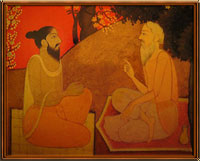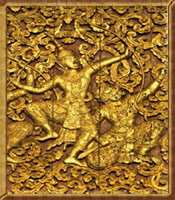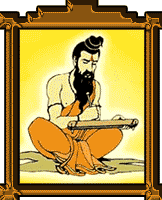INTRODUCTION
The Upanishads, an amazing collection of writings form the core of Indian philosophy considered to be an early source of Hindu religion, which has been aptly described by Shri Aurobindo as "the supreme work of the Indian mind". All the fundamental teachings of Hinduism, viz. the concepts of 'karma' (action), 'samsara' (rebirth), 'moksha' (liberation from samsara), the 'atman' (soul), and the 'Brahman' (Absolute Power, the Almighty) are dealt with in the Upanishads. The principles of self-realization, yoga and meditation which are the vital doctrines of the Vedas are also set forth here and the spiritual vision and philosophical arguments are commendable.
MEANING OF THE WORD UPANISHAD
Several meanings are attributed to 'Upanishad', the literal meaning being, "sitting down near" or "sitting close to". This may mean listening closely to the mystical doctrines of a learned guru or a spiritual teacher. Upanishad also has different meanings such as "placing side by side" (equivalence or correlation), a "near approach" (to the Absolute Being), "secret wisdom" or even "sitting near the enlightened" and can be inferred according to one's own imagination.PERIOD OF COMPOSITION

The Muktika Upanishad, which predates 1656, contains a list of 108 canonical Upanishads, the last in the list being Muktika Upanishad itself. New Upanishads were still composed in the medieval and early modern period. Discoveries of newer Upanishads were being reported as late as 1926, some of which did not deal with subjects of Vedic philosophy. The newer Upanishads are very much imitations of the mukhya Upanishads.
AUTHORS

Dara Shikoh, son of the Mughal emperor Shah Jahan, translated 50 Upanishads into Persian in 1657.The first written English translation came in 1805 from Colebrook, who was aware of 170 Upanishads. Sadhale's catalog from 1985, the Upanisad-vakya-maha- kosa, lists 223 Upanishads. The Upanishads are mostly the concluding part of the Brahmanas and in the Aranyakas. 'The Upanishads' is one of the most significant books written by the British poet Martin Seymour-Smith.
The Bhagavad-Gita (the great teachings of Lord Krishna rendered to Arjuna just before the battle of Krukshetra) is also considered to be an Upanishad because it contains the essence of many of the Upanishads.
ESSENCE OF UPANISHADS

CONCLUSION
The Upanishads are a set of guidelines that pave way to attain brahma-knowledge through Vedanta. The different derivations together make out that they give us both spiritual vision and philosophical reasoning.The sages who discovered them wanted to go beyond nature in search of transcendental nature of man. They dared to take up this challenge and the Upanishads are the unique record of the methods they adopted, the struggles they undertook and the victory they achieved in this astonishing adventure of human spirit. In seeking the immortal, the sages conferred the immortality upon the literature they have passed on to us.One of the oldest and longest of the Upanishads, the Brihadaranyaka says: "From the unreal lead me to the real! From darkness lead me to light! From death lead me to immortality!"The crux of the Upanishads is that this can be achieved by meditating with the awareness that one's soul ('atman') is one with all things, and that 'one' is 'Brahman', which becomes the 'all'..


